Choosing the Best Beef Cuts for Slow Cooker Stew


Intro
When it comes to slow cooker stew, one of the unsung heroes in the kitchen is undoubtedly the beef you select. Getting it right can make all the difference between a mediocre meal and something that'll have everyone coming back for seconds. But why is the choice of beef so crucial? Different cuts deliver varying flavors, textures, and tenderness, especially when cooked low and slow. This article dives into the nitty-gritty of choosing the ideal beef for your stew, ensuring your culinary creations become a standout feature at the dinner table.
Recipe Overview
Recipe Name and Description
Hearty Slow Cooker Beef Stew
This comforting dish showcases tender chunks of beef simmered with a colorful mix of vegetables, all in a rich, flavorful broth that warms the soul. The slow cooking process allows the flavors to meld beautifully, creating a dish that’s perfect for family gatherings or chilly evenings.
Cuisine Type
While stew can be found in many cultures, this particular recipe draws inspiration from classic American and European homestyle cooking. It embodies simplicity, warmth, and a focus on quality ingredients, representing rustic family meals that have stood the test of time.
Ingredients List
Detailed Ingredient Breakdown
- Beef Cuts: Chuck roast, brisket, or flank steak are excellent choices, each contributing their unique textural characteristics.
- Vegetables: Carrots, potatoes, and onions bring sweetness and depth. Mushrooms add an earthy note.
- Broth: Beef broth or stock provides a rich base; consider homemade if possible.
- Herbs and Spices: Thyme, bay leaves, and black pepper enhance flavors—don’t shy away from adding a splash of red wine for depth.
- Thickening Agents: Flour or cornstarch can be used to give the stew a pleasing body.
Substitutions for Dietary Needs
- Gluten-Free: Swap flour with a gluten-free thickening agent, like cornstarch or arrowroot.
- Vegetarian Option: Replace beef with hearty mushrooms and use vegetable broth in place of beef broth for a satisfying stew, though the texture will differ.
- Lower Fat: If you're looking to cut the fat, lean cuts like sirloin or round can serve well, but do not expect the same richness in flavor as the fattier cuts.
"The secret ingredient is always the beef. Choose wisely for a stew that warms both the heart and the palate."
Culmination
The choice of beef is fundamental to the success of slow cooker stew. By understanding the strengths of various cuts, you can create an unforgettable meal that highlights the true essence of comfort food. Whether you're feeding a crowd or indulging in a cozy evening alone, knowing how to select the right beef ensures your stews will always be met with praise.
Understanding Slow Cooker Stew
When it comes to preparing a hearty meal with minimal fuss, few methods can rival the slow cooker. Understanding slow cooker stew is not merely about throwing ingredients into a pot; it’s about grasping the subtle techniques and flavors that emerge through low and slow cooking. This culinary practice is steeped in tradition and offers a host of benefits that can transform even the simplest of ingredients into a delightful dish.
The Art of Slow Cooking
Slow cooking is a dance of time and temperature. What makes it an art form is the ability to coax flavors from beef and vegetables, allowing them to meld and develop over hours. At the core of this process lies the Maillard reaction, which is what gives browned meat its delicious flavor. Even though you start with raw ingredients, the slow process allows the beef to absorb the juices of the vegetables, and vice versa. This creates a rich, layered flavor profile that can’t be rushed.
Cooking at a low temperature—typically around 190°F to 210°F—ensures that tough cuts of beef break down beautifully. The fats and connective tissues dissolve, contributing to a tender texture in the meat. Each slice you serve will be the result of patience and careful understanding of what heat does to raw ingredients.
Benefits of Slow Cooking
The advantages of slow cooking are numerous, making it an attractive option for both seasoned chefs and kitchen novices. Some of these benefits include:
- Flavor Enhancement: As ingredients simmer slowly, their flavors intertwine, leading to a deeper, more robust taste.
- Nutrition Preservation: Cooking at lower temperatures can help to retain vitamins and minerals that may be lost in other cooking methods.
- Convenience: Once everything is prepped and loaded into the pot, there's little left to do but let it cook. Home cooks can go about their day without constant supervision.
- Economical Use of Ingredients: Cheap cuts of beef, often considered tough, can shine in a slow cooker. Rather than being overlooked or avoided, these cuts transform into the centerpiece of a satisfyingly hearty meal.
"Cooking is one of the oldest forms of self-care, and slow cooking is the sweetest, most patient way to do it."
Ultimately, understanding slow cooker stew can elevate your cooking game, leading to creations that are both nourishing and flavorful. Mindfully selecting your ingredients and embracing the slow cooking method can set the stage for a dish that becomes a staple in your culinary repertoire.
Cutting Through Confusion: Types of Beef for Stew
Selecting the right beef for your slow cooker stew can seem like navigating a maze, especially with so many cuts available. Each cut has its own unique characteristics that can drastically change the taste and texture of the final dish. Knowing what to look for and understanding the differences among them is crucial. This section aims to clear the fog, presenting a breakdown of popular beef cuts, their benefits, and considerations when it comes to slow-cooking.
Chucks: A Staple Choice

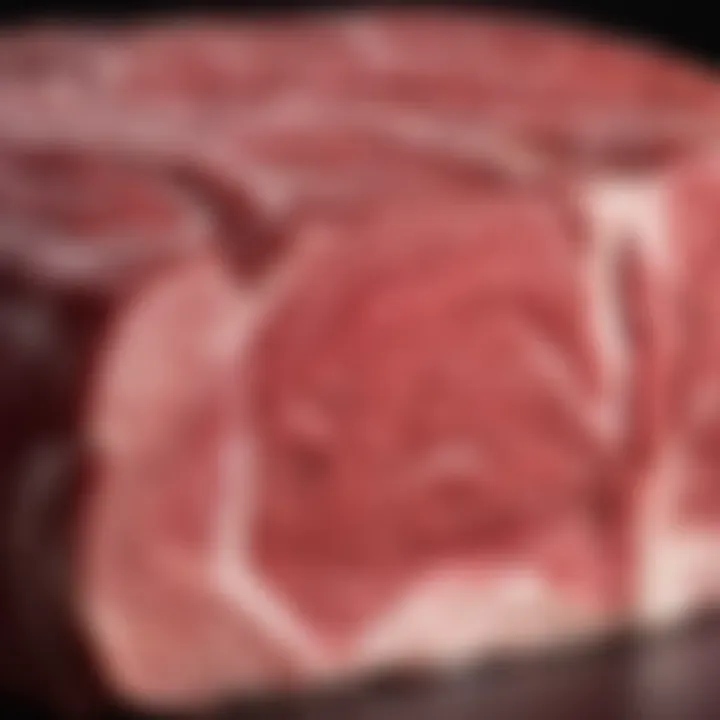
Chuck cuts, often referred to simply as "chuck," remains a favorite among stew aficionados. This cut comes from the shoulder region of the cow, ensuring a good balance of meat and fat. The marbling in chuck helps to keep the meat moist throughout the long cooking process, enhancing the overall flavor.
When it comes to tenderness, chuck is known to become very soft after several hours in the slow cooker. However, it is advisable to choose well-marbled chuck, as leaner cuts may turn out a bit tough. Additionally, chuck tends to be more economical compared to some other cuts, making it an attractive option for families looking to stretch their dollars without sacrificing taste.
Brisket: Subtle Richness
Brisket is renowned for its rich, beefy flavor. It comes from the breast area of the cow and is packed with connective tissue that breaks down beautifully during slow cooking. This cut is often favored for its depth of flavor, providing a slightly sweeter taste compared to chuck.
Opting for brisket can introduce a variety of textures to your stew. The fat cap on top also aids in moisture retention, leading to a luscious experience. Just make sure to slice it against the grain when serving to maximize tenderness.
Round Cuts: Lean but Flavorful
Round cuts, including top round and bottom round, come from the hind leg of the cow. These cuts are noticeably leaner compared to chuck and brisket but still hold considerable flavor when cooked properly. While round might lack the fat content typically associated with stewing cuts, the flavors can still shine through—especially with the right seasoning.
Using round cuts can be a smart choice for those seeking a healthier option without entirely sacrificing meat quality in their stew. They might require slightly longer cooking times to become tender, so that’s something to factor in when planning your meal.
Short Ribs: Indulgent Texture
Short ribs can elevate any stew, introducing an indulgent richness that's hard to match. These cuts are well-marbled and come from the lower rib area, where fat and meat intertwine, yielding incredible flavor during the cooking process. Their texture becomes unctuous after several hours of slow cooking, inviting everyone to savor each bite.
A point worth mentioning is that short ribs often contribute a touch of luxury to your stew. While they may be pricier than chuck or round cuts, the investment pays off in terms of flavor and satisfaction. Many chefs will recommend short ribs for those special gatherings where a remarkable dish is on the menu.
Evaluating Beef Quality
When it comes to crafting a sumptuous slow cooker stew, one cannot overlook the crucial step of evaluating the quality of beef. The notion of quality is not just about the cut; it encompasses a range of factors that can majorly impact the flavor, texture, and overall satisfaction derived from the final dish. Understanding beef quality is essential because it influences how well the meat cooks, its tenderness, and even its seasonality, which all affects the harmony of flavors in your stew.
Choosing high-quality beef can elevate your dish from merely adequate to truly memorable. By focusing on specific elements such as the grading system, marbling, and color, you can make informed decisions that resonate well with your culinary aspirations. Let's dive deeper into these considerations.
Understanding Grades of Beef
Beef is categorized into different grades by organizations that evaluate significant criteria, one being intramuscular fat — marbling. The USDA classification system, which is predominantly recognized in the U.S., outlines various grades of beef, including Prime, Choice, Select, and Standard. Each grade has its own unique characteristics.
- Prime: Often sourced from younger cattle, this type boasts an abundance of marbling, leading to enhanced flavor and tenderness. Prime is ideal for slow cooking, as it remains succulent even with prolonged exposure to heat.
- Choice: Slightly less marbled than Prime, this grade is still a robust choice for stews. It offers great flavor without being overly fatty, making it quite versatile.
- Select: Usually leaner with limited marbling, this type can be an economical option. However, it may require extra care during cooking to prevent it from becoming tough and chewy.
The grade of the beef not only suggests the quality but also dictates the expected cooking results, making it a critical aspect in the selection process.
Marbling Impact on Flavor
Marbling refers to the white flecks of fat interspersed within the muscle tissue. This fat has a significant impact on the way beef flavors develop throughout the cooking process. The connection between marbling and flavor can be likened to a well-aged wine; the more nuanced the fat distribution, the richer the taste.
- Higher marbling enhances tenderness, elevating the mouthfeel as you enjoy your stew. As it cooks, the fat melts and infuses the lean meat, resulting in a taste experience that is succulent and robust.
- Conversely, leaner cuts lacking in marbling can result in stews that are dry and lack depth. Though these cuts can work, utilizing rich marbled beef can transform your dish into a comforting masterpiece.
"High-quality beef with good marbling is essential for achieving the kind of melt-in-your-mouth tenderness that one craves in a slow-cooked stew."
When you select your beef, don't just look for a cut; consider the marbling as a vital narrative in your stew's story. The right combination of beef grading and marbling will create satisfying flavors that dance on the palate, making your slow cooker stew something to write home about.
Preparation Techniques for Beef Stew
Proper preparation techniques can make a world of difference in your slow cooker stew. It’s not just about what cut of beef you select, but how you handle that meat before it even hits the pot. Proper prep not only ensures quality but also greatly enhances the flavor. A well-cooked stew is a symphony of tastes and textures, and every little step leading up to it counts. Whether you are a seasoned home chef or a hobbyist, understanding the nuances of meat preparation is essential.
Trimming: Ensuring Quality
Trimming is a critical step in preparing beef for your stew. It's the process of removing excess fat, connective tissue, or any undesirable bits from the meat. While some fat can contribute flavor, too much can lead to a greasy stew, which is less than appetizing. Here are some key points to consider regarding trimming:
- Visual Inspection: Look closely at your beef. Any areas that appear overly fatty or tough should be trimmed away. It might not look pretty, but it’ll pay off in the end.
- Textures Matter: Different cuts have different textures. For example, chuck can have more connective tissue that breaks down beautifully during slow cooking, while round cuts might be leaner but require a good trim to ensure tenderness.
- Mechanical Tenderness: If you’re working with tougher cuts, consider slicing against the grain. This can help break up the muscle fibers, making the meat more palatable in your stew.
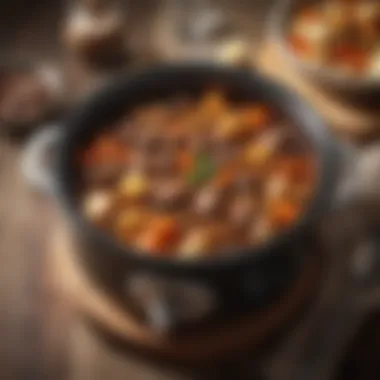
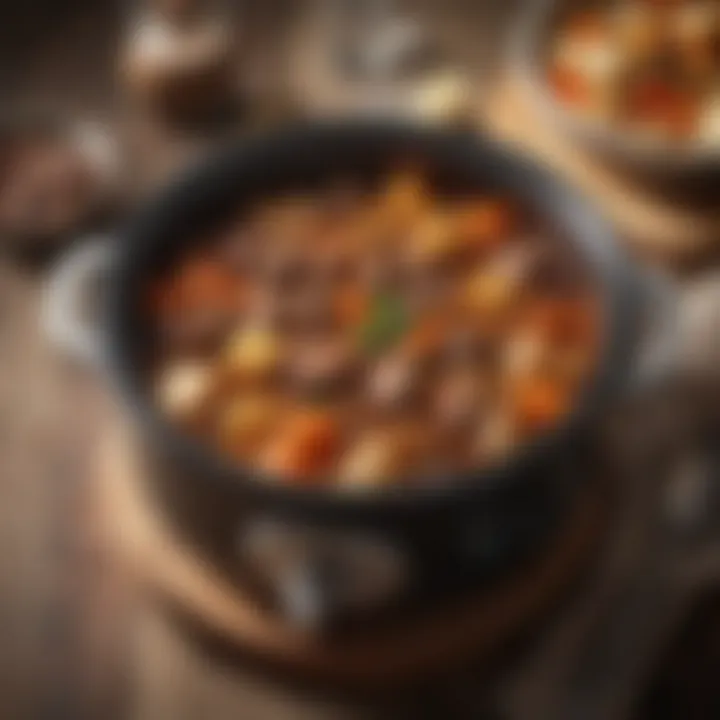
"A well-trimmed piece of meat is less likely to become a rubbery affair in your slow cooker."
Browning the Meat: Enhancing Depth
Browning is another step that should not be overlooked. This helps develop a deeper flavor profile through the Maillard reaction, which occurs when meat is seared at a high temperature. Here's why you should bother with this step:
- Creating Layers of Flavor: Browning the beef creates a complex combination of flavors that will enrich your stew. You might be tempted to skip this when using a slow cooker, but taking the moment to sear is worth it.
- Crispy Texture: It adds texture contrast. If done right, these browned bits will provide a delightful bite, amidst the softer elements in your stew.
- Deglazing for Extra Flavor: After browning, don’t discard those browned bits in the pan! Deglaze with a bit of broth or wine and scrape those flavorful bits into your slow cooker. This is how good stews get their depth.
To summarize, preparation techniques such as trimming and browning not only enhance the quality of the beef but also set the foundation for developing incredible flavors in your slow cooker stew. Attention to these details can elevate your dish from ordinary to extraordinary.
Ingredient Pairings for Optimal Stew
When thinking of crafting a delightful slow cooker stew, the beef cuts are only part of the equation. Sure, picking the right meat is crucial, but what about what mingles with it? Ingredient pairings can elevate your stew from merely good to downright scrumptious. By understanding which vegetables, herbs, and spices work harmoniously together, you strive for a flavor profile that tantalizes the palate.
Vegetable Companions
Vegetables play a vital role in any stew. They not only add texture and body but also contribute to the overall taste. It's essential to choose veggies that can hold their own during the lengthy cooking process without turning mushy. Consider these options:
- Carrots: Their natural sweetness balances the savory elements of the beef, yielding a pleasing contrast.
- Potatoes: Starches bind flavors together while absorbing the aromatic juices, creating a creamy consistency as they cook.
- Celery: This adds a bit of crunch and a subtle earthy flavor that complements the meat well.
- Onions: A base seasoning staple, they can add depth to the stew, caramelizing and enhancing overall flavor when cooked low and slow.
A well-rounded onion, like a yellow onion, is a solid choice, as it becomes sweeter and more fragrant during the cooking process. Remember to cut your vegetables in chunks that are not too small so they hold up over time.
Herbs and Spices: Flavor Foundations
This is where artistry comes into play. Choosing the right herbs and spices can turn a standard stew into something truly memorable. Here’s a brief rundown of fantastic flavor enhancers:
- Bay Leaves: Perfect for infusing subtle flavor over long cooking times; just don’t forget to fish them out before serving!
- Thyme: A little sprinkle of this herb can provide earthiness without overwhelming the other flavors in the stew.
- Rosemary: Its distinct piney flavor pairs well with beef, but use it sparingly—too much can take over the dish.
- Paprika: This spice adds warmth and a hint of smokiness that complements beef beautifully.
- Garlic: Not a herb, but certainly not forgotten! Minced or whole, it adds a punch to the stew.
Creating a balance is essential. Feel free to adjust based on what you like, but it's better to start with a lighter hand; you can always add more later. Experimentation can lead to standout dishes that infuse your kitchen with irresistible aromas.
"The right blend of ingredients is like a symphony—each element plays its part in a harmonious performance."
As such, successful pairings of vegetables and seasoning can ensure that your stew not only warms the heart but also dazzles the taste buds. This careful crafting of flavors through thoughtful pairings is where the magic happens.
Troubleshooting Common Stew Issues
When it comes to making a hearty slow cooker stew, it’s easy to find oneself staring down at a simmering pot, puzzled over why things haven’t gone as planned. Understanding how to troubleshoot common issues with your stew is an invaluable skill. It allows both novice and experienced cooks to fine-tune their methods, ensuring that every bowl served is bursting with flavor and the perfect texture. By recognizing potential pitfalls and learning how to address them, you empower yourself to create a stew that garners compliments at the dinner table.
Tough Meat: Causes and Solutions
Encountering tough meat in your slow cooker stew can feel like an uphill battle. One of the main reasons for toughness is the cut of beef you chose. Cuts from well-exercised muscles, like the chuck or round, may require a longer cooking time to break down tough fibers. Another factor could be the cooking time itself. If the beef isn't left to stew long enough, it simply won't reach that melt-in-the-mouth tenderness you’re aiming for.
- Solution 1: Choose Proper Cuts
Opt for cuts that are high in connective tissue, such as chuck or short ribs, which break down beautifully over long cooking periods. - Solution 2: Adjust Cooking Time
For really tough cuts, consider extending the cooking time. A good rule of thumb is to check for doneness and tenderness after 7-8 hours on low. If it's still firm, let it go longer. - Solution 3: Check Liquid Levels
Ensuring there’s enough liquid can also make a world of difference. If the meat sits above the liquid for too long, it can dry out. Make sure it’s partially submerged for even cooking.
"Patience is a virtue most important when working with slow-cooked meats."
Flavor Balance: Addressing Blandness
Tasting your slow cooker stew only to find it lacking in flavor can be disheartening. There are a few common reasons behind a bland stew, ranging from insufficient seasoning to a lack of robust flavor from ingredients. Initially, it is crucial to salt your meat before browning, as it will help in building an essential flavor base.
- Tip 1: Season Early and Often
Don’t wait until the end to season your stew. Season during browning and afterwards, tasting regularly to build layers of flavor. - Tip 2: Add Acid for Brightness
A splash of vinegar or a squeeze of lemon can cut through heaviness and elevate the flavors. Incorporating acidic components helps balance the richness of the meat. - Tip 3: Use Quality Broth
The type of liquid you choose plays a monumental role. Broth or stock made from scratch will yield a more complex flavor compared to store-bought. If you’re in a pinch, consider adding a dash of soy sauce or Worcestershire sauce to enhance umami notes. - Tip 4: Include Herbs and Spices
Fresh herbs added in the last hour of cooking can boost flavor. Dried spices should be introduced at the onset, as they benefit from the slow-cooking process.
Ultimately, troubleshooting these common stew issues can transform a mere meal into a comforting bowl of magic, warming both bellies and hearts.
The Role of Timing in Slow Cooking
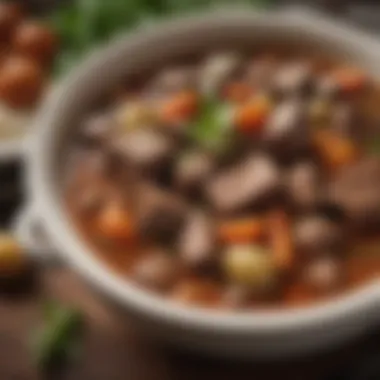
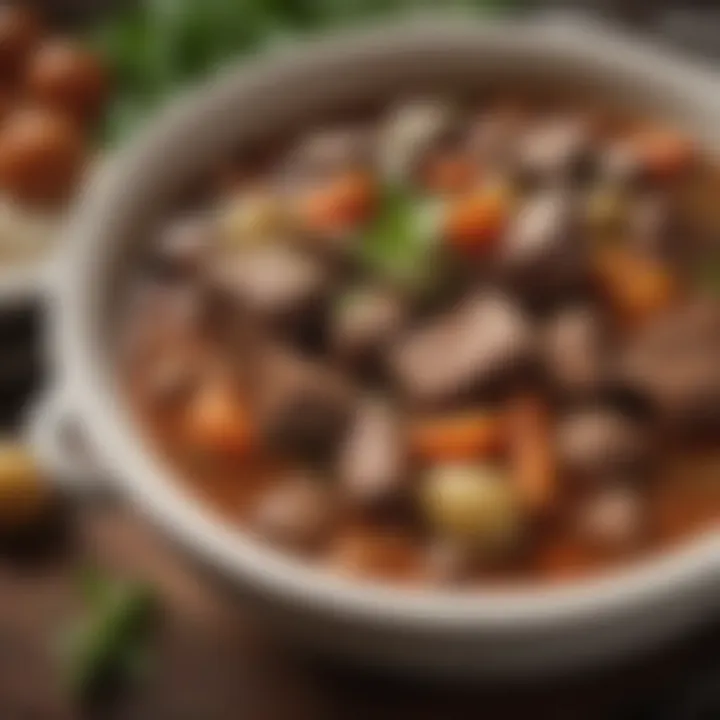
When it comes to crafting the perfect slow cooker stew, timing isn't just a matter of convenience; it’s paramount to achieving the desired flavor and texture. The way you time your cooking influences how the ingredients meld, how the meat breaks down, and ultimately, the overall quality of your stew. A well-timed stew has a depth of flavor that's hard to beat.
Cook Time Influence on Texture
The cook time plays a crucial role in how the meat transforms from tough to tender. With an emphasis on the cuts used, longer cooking times allow the connective tissues in tougher cuts to break down, leading to that melt-in-your-mouth texture. Typically, a cook time of 6 to 8 hours on low heat is recommended for tougher cuts such as chuck or brisket.
If you're pushing for a faster cook, many opt for the high setting, which reduces the time to about 3 to 4 hours. However, be cautious—taking shortcuts can make meat chewy rather than juicy. A longer simmer also means that vegetables, herbs, and spices have more time to release their flavors, creating a more harmonious dish.
- Tenderness: Longer cook times enhance tenderness.
- Juiciness: Extended cooking prevents dryness in thicker cuts.
- Flavor Development: The melding of flavors is best achieved over longer periods.
Cooking times can be adjusted depending on the specific cut of beef you selected. Always probe the meat with a fork towards the later stages. If it shreds easily, you're likely ready to serve.
Temperature Variances: Low vs. High Settings
Knowing when to set your cooker on low and when to crank it up to high is all in the timing. As a general guideline, low settings are designed for long, slow cooking. High settings, on the other hand, speed up the process but often compromise the final texture.
- Low Setting: This is ideal for deeper flavors. The gentler heat coax larger amounts of flavor from the ingredients without racing through the cooking process. It allows collagen in beef to dissolve into gelatin, enriching the broth.
- High Setting: Useful when time is of the essence, but it introduces risks. The stews may not attain the same complexity in flavor. Overheating can lead to unevenly cooked vegetables while soybeans or lentils can get mushy, losing their texture.
In many scenarios, the best practice would be to start the stew on high to jump-start the heating process, particularly for larger batches, and then switch to low for the remainder of the cooking period to fully develop flavors and textures without overcooking.
Remember: Adjusting your timing and temperature settings wisely can mean the difference between a stew that sings with flavor and one that falls flat.
Serving Suggestions and Storage Tips
Ideal Pairings: What to Serve with Stew
When it comes to serving slow cooker stew, choosing the right accompaniments is key. Here are some stellar options:
- Crusty Bread: A hunk of sourdough or a baguette is perfect for soaking up that rich broth. There's something undeniably satisfying about tearing off a piece of bread and sopping up the last remnants of your stew.
- Creamy Polenta: A bowl of soft polenta can also make a wonderful base. Its buttery flavor and smooth texture complement the hearty nature of the stew beautifully.
- Simple Green Salad: For a touch of freshness, consider a crisp green salad. It adds a nice contrast and helps balance the richness of the meat.
- Cheesy Mashed Potatoes: If you’re in the mood for something warm and comforting, mashed potatoes with a hint of cheese can make a delightful side.
- Mashed Cauliflower: For a healthier option, mashed cauliflower can deliver a similar creamy experience without the carbs.
These pairings not only enhance flavors but also create a well-rounded meal. Each element contributes something unique, allowing the stew to shine in all its glory.
Storage Solutions for Leftovers
After a hearty meal, you may find yourself with leftovers. It’s wise to know how to store them properly for future enjoyment. Here are some guiding thoughts:
- Cooling Before Storage: Let the stew cool to room temperature before moving it into storage containers. This helps avoid condensation and maintains the flavor integrity.
- Use Airtight Containers: Choose containers that are airtight to prevent your stew from absorbing other odors in the fridge.
- Label and Date: Don’t forget to label each container with a date. This simple step ensures you keep track of how long you’ve had it stored.
- Refrigeration: If you plan to consume the leftovers within a few days, refrigeration is sufficient. Generally, it’s best to eat refrigerated stew within 3-4 days.
- Freezing for Longevity: If you want to enjoy it later, consider freezing portions. Just make sure to leave some space in the container for expansion.
- Reheating: When it's time to eat again, reheat gently on the stove or in the microwave until it’s thoroughly warmed through. You may need to add a splash of broth or water, as freezing can sometimes alter the consistency.
By following these tips, you can preserve the deliciousness of your stew and always have a comforting meal on hand for those busy nights.
"Good food is all the sweeter when shared with good friends."
Making a slow cooker stew and enjoying it with loved ones can create bonds that go well beyond the dinner table.
Epilogue: Crafting a Memorable Slow Cooker Stew
When it comes to making a slow cooker stew that leaves everyone craving more, the choice of beef is paramount. Every piece of meat tells its own story; from the cut selected to the way it's cooked. In this article, we have explored the various types of beef suitable for slow cooking, understanding their unique qualities helps enhance both texture and flavor.
Understanding the significance of suitable beef cuts can turn an ordinary dish into an extraordinary one. A chuck roast can provide that hearty, comforting profile, while brisket may offer a more refined richness to your stew. The beef's fat content, influenced by various grades, plays an essential role in achieving that melt-in-your-mouth texture that is characteristic of an ideal slow-cooked meal. Moreover, recognizing the importance of marbling opens up a realm of flavors, integrating them seamlessly into your final dish.
Benefits of Thoughtful Selection
- Quality beef not only affects taste but also influences overall satisfaction when serving. A well-selected cut creates a stew that the whole family will enjoy.
- Selecting the right beef encourages proper cooking techniques, such as browning, that enrich the taste. The caramelized exterior adds depth, preventing your stew from tasting flat or dull.
- Finally, achieving that perfect stew consistency relies on timing—long, slow cooking transforms tough cuts into succulent pieces that absorb flavors well, thus elevating the entire meal.
In crafting a memorable slow cooker stew, it’s clear that beef selection lays the foundation. By emphasizing these elements, anyone can transform their stew from mundane to magnificent, creating a warming dish that feels like a hug in a bowl.
"The secret to great flavor often lies in the beef you select. Choose wisely, and your slow cooker will reward you with a stew that satisfies the soul."
Final Thoughts on Beer Selection
When finishing touches come into play, many home cooks may turn to an unexpected but excellent partner: beer. Adding a splash of stout or even a light lager to your slow cooker can enhance richness and depth, perfectly complementing the beef. The key here is to match the beer’s characteristics with the flavor profile of your stew. A robust porter can bring an earthiness that pairs beautifully with beef, while a pilsner might add a crisp brightness for lighter versions. Additionally, cooking with beer can introduce layers of complexity, lending a delightful finish to the overall dish.
In sum, seasoning and cooking with a perspective towards beer selection adds another dimension to perfecting your stew, making a meal not just taste good but also resonate with those enjoying it.















